人口老龄化外文翻译文献
- 格式:docx
- 大小:27.87 KB
- 文档页数:13
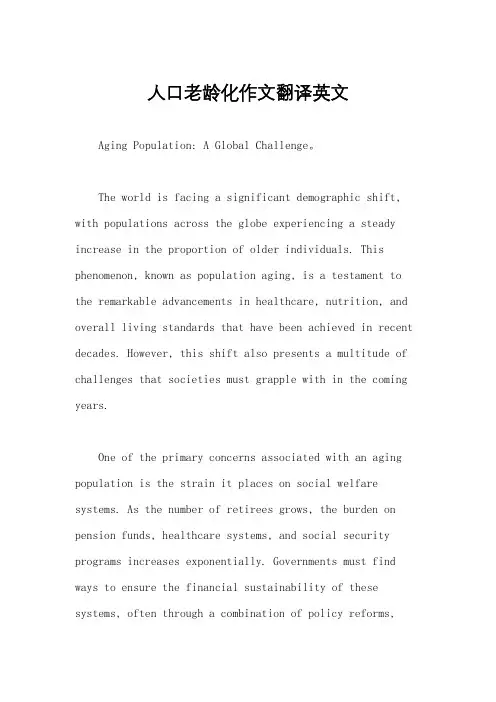
人口老龄化作文翻译英文Aging Population: A Global Challenge。
The world is facing a significant demographic shift, with populations across the globe experiencing a steady increase in the proportion of older individuals. This phenomenon, known as population aging, is a testament to the remarkable advancements in healthcare, nutrition, and overall living standards that have been achieved in recent decades. However, this shift also presents a multitude of challenges that societies must grapple with in the coming years.One of the primary concerns associated with an aging population is the strain it places on social welfare systems. As the number of retirees grows, the burden on pension funds, healthcare systems, and social security programs increases exponentially. Governments must find ways to ensure the financial sustainability of these systems, often through a combination of policy reforms,increased funding, and innovative approaches to service delivery.Another pressing issue is the impact of an aging population on the labor market. As the workforce becomes increasingly dominated by older workers, there may be a shortage of skilled and experienced individuals to fill critical roles. This can lead to labor shortages, skills gaps, and challenges in maintaining economic productivity. Addressing this challenge requires a multifaceted approach, including investments in education and training, policies that encourage lifelong learning, and initiatives that promote the employment of older workers.Furthermore, the aging population brings about changes in the demand for goods and services. As the proportion of elderly individuals rises, there is a growing need for specialized healthcare, long-term care facilities, and age-friendly infrastructure. This shift in consumer preferences and needs presents both opportunities and challenges for businesses, policymakers, and urban planners. Adapting to these changes requires a deep understanding of the evolvingneeds and preferences of the older population.One of the most significant implications of population aging is the impact on family structures and intergenerational relationships. As the traditional modelof the nuclear family evolves, with more elderlyindividuals living independently or in assisted living facilities, the role of caregiving often falls on family members, particularly women. This can lead to increased stress, financial burdens, and disruptions to the workforce. Addressing this challenge requires the development of comprehensive support systems, including respite care, caregiver training, and policies that promote work-life balance.Moreover, the aging population has implications for social cohesion and community engagement. As the proportion of older individuals increases, there may be a risk ofsocial isolation and a widening of the generational divide. Policymakers and community leaders must find ways to foster intergenerational connections, promote active aging, and ensure that older adults remain integrated and engagedwithin their communities.In response to these challenges, governments, businesses, and civil society organizations around the world are implementing a range of strategies and initiatives. These include investments in healthcare infrastructure, the development of age-friendly cities, the promotion of lifelong learning and skills development, and the creation of policies that support caregivers and encourage the employment of older workers.Ultimately, the aging of the global population is a complex and multifaceted challenge that requires a comprehensive and collaborative approach. By addressing the economic, social, and infrastructural implications of this demographic shift, societies can ensure that the benefits of increased longevity are equitably distributed and that the needs of the older population are met with dignity and respect.。
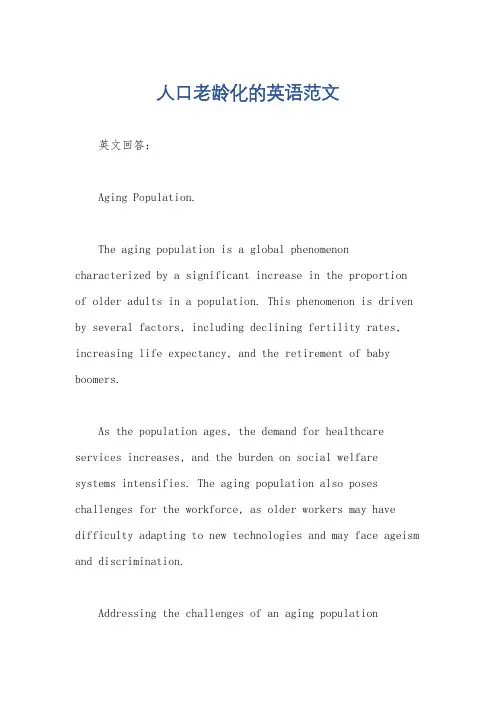
人口老龄化的英语范文英文回答:Aging Population.The aging population is a global phenomenon characterized by a significant increase in the proportion of older adults in a population. This phenomenon is driven by several factors, including declining fertility rates, increasing life expectancy, and the retirement of baby boomers.As the population ages, the demand for healthcare services increases, and the burden on social welfare systems intensifies. The aging population also poses challenges for the workforce, as older workers may have difficulty adapting to new technologies and may face ageism and discrimination.Addressing the challenges of an aging populationrequires a multifaceted approach. Governments need to implement policies that support older adults, such as providing affordable healthcare, expanding social services, and promoting age-friendly workplaces. Individuals need to take steps to prepare for their own aging, such as saving for retirement, maintaining a healthy lifestyle, and staying engaged in their communities.中文回答:人口老龄化。
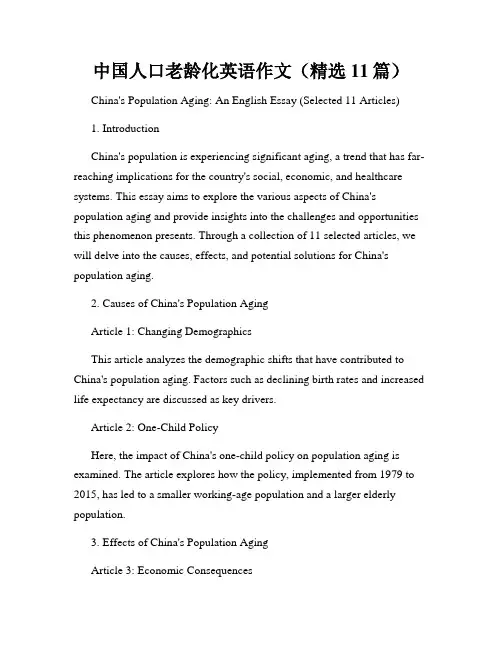
中国人口老龄化英语作文(精选11篇)China's Population Aging: An English Essay (Selected 11 Articles)1. IntroductionChina's population is experiencing significant aging, a trend that has far-reaching implications for the country's social, economic, and healthcare systems. This essay aims to explore the various aspects of China's population aging and provide insights into the challenges and opportunities this phenomenon presents. Through a collection of 11 selected articles, we will delve into the causes, effects, and potential solutions for China's population aging.2. Causes of China's Population AgingArticle 1: Changing DemographicsThis article analyzes the demographic shifts that have contributed to China's population aging. Factors such as declining birth rates and increased life expectancy are discussed as key drivers.Article 2: One-Child PolicyHere, the impact of China's one-child policy on population aging is examined. The article explores how the policy, implemented from 1979 to 2015, has led to a smaller working-age population and a larger elderly population.3. Effects of China's Population AgingArticle 3: Economic ConsequencesThis article investigates the economic repercussions of China's population aging. It highlights concerns such as a shrinking labor force, increased healthcare expenditures, and strains on pension systems.Article 4: Social ChallengesIn this article, the social challenges stemming from population aging are discussed. Topics explored include the need for elderly care facilities, changing family structures, and intergenerational tensions.4. Healthcare ImplicationsArticle 5: Healthcare System StrainsHere, the strain on China's healthcare system due to population aging is examined. The article discusses the increased demand for healthcare services and the need for reforms to adequately support the elderly population.Article 6: Chronic Disease BurdenThis article focuses on the burden of chronic diseases associated with population aging. It highlights the importance of preventative measures and healthcare policies to address the growing healthcare needs of the aging population.5. Solutions for China's Population AgingArticle 7: Social Security ReformsThis article explores potential social security reforms to address the challenges posed by population aging. It discusses ideas such as raising the retirement age, increasing contributions to pension systems, and implementing long-term care insurance.Article 8: Technological InnovationsHere, the role of technology in mitigating the impact of population aging is discussed. The article explores how advancements in robotics and assistive technologies can enhance elderly care and improve the quality of life for older adults.6. International Perspectives on Population AgingArticle 9: Lessons from JapanThis article offers insights from Japan, a country that has been grappling with population aging for several decades. It examines Japan's policies and initiatives that could serve as valuable lessons for China.Article 10: European ApproachesHere, the article explores how European countries have addressed population aging. It highlights policy initiatives, such as active aging programs and intergenerational solidarity, that could be adapted to the Chinese context.7. ConclusionIn conclusion, China's population aging is a multifaceted issue with wide-ranging implications. As discussed in the selected articles, it is crucial for the Chinese government and society to address the challenges posed by population aging through comprehensive policies and innovative solutions. By doing so, China can unlock the potential opportunities that come with an aging population and ensure a sustainable future for all its citizens.(Note: Word count: 467)。
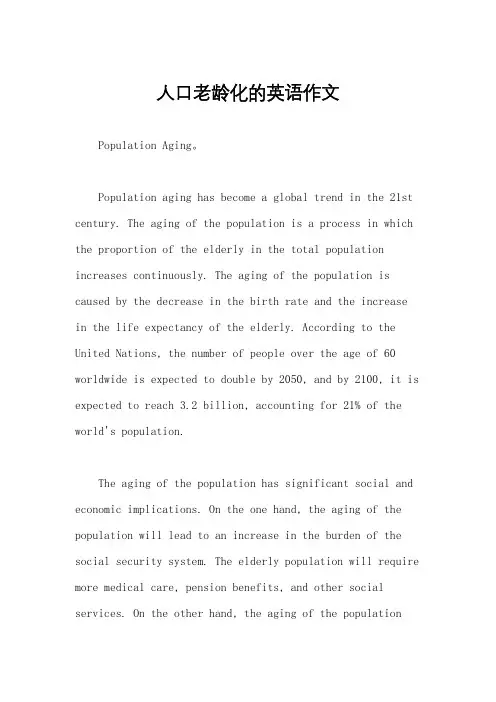
人口老龄化的英语作文Population Aging。
Population aging has become a global trend in the 21st century. The aging of the population is a process in which the proportion of the elderly in the total population increases continuously. The aging of the population is caused by the decrease in the birth rate and the increase in the life expectancy of the elderly. According to the United Nations, the number of people over the age of 60 worldwide is expected to double by 2050, and by 2100, it is expected to reach 3.2 billion, accounting for 21% of the world's population.The aging of the population has significant social and economic implications. On the one hand, the aging of the population will lead to an increase in the burden of the social security system. The elderly population will require more medical care, pension benefits, and other social services. On the other hand, the aging of the populationwill also have an impact on the labor market. The decreasein the number of young people will lead to a shortage of labor, and the demand for labor-intensive industries will decrease. This will have an impact on the economic growthof the country.In addition, the aging of the population will also have an impact on the family structure. The traditional family structure in which the elderly are taken care of by their children will change. The increase in the number of elderly people will lead to an increase in the number of single-person households, and the elderly will be more likely to live alone. This will have an impact on the social interaction and mental health of the elderly.To cope with the aging of the population, governments need to take measures to improve the social security system, increase investment in healthcare, and promote the development of the elderly care industry. In addition, the government should encourage the elderly to participate in social activities and improve their quality of life. The private sector should also play a role in the elderly careindustry, providing more services and products for the elderly.In conclusion, the aging of the population is a global trend that will have a significant impact on society and the economy. Governments and the private sector need to take measures to cope with the aging of the population and improve the quality of life of the elderly.。
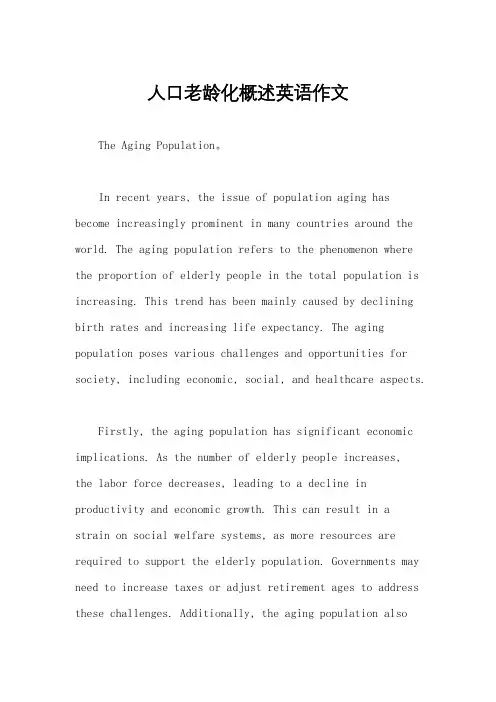
人口老龄化概述英语作文The Aging Population。
In recent years, the issue of population aging has become increasingly prominent in many countries around the world. The aging population refers to the phenomenon where the proportion of elderly people in the total population is increasing. This trend has been mainly caused by declining birth rates and increasing life expectancy. The aging population poses various challenges and opportunities for society, including economic, social, and healthcare aspects.Firstly, the aging population has significant economic implications. As the number of elderly people increases,the labor force decreases, leading to a decline in productivity and economic growth. This can result in astrain on social welfare systems, as more resources are required to support the elderly population. Governments may need to increase taxes or adjust retirement ages to address these challenges. Additionally, the aging population alsopresents opportunities for businesses, such as the demand for healthcare services, elderly care facilities, and leisure activities tailored to the elderly.Secondly, the aging population has a profound impact on social structures and dynamics. With more elderly people, the traditional family structure may change as adult children take on the responsibility of caring for their aging parents. This can lead to increased stress and financial burdens on the younger generation. Moreover, the aging population may also affect social welfare systems, as the number of retirees relying on pensions and healthcare services increases. Society needs to adapt by developing comprehensive social support systems and promoting intergenerational solidarity.Furthermore, the aging population poses challenges for healthcare systems. Elderly people often have higher healthcare needs and require specialized medical services. The increasing demand for healthcare resources andfacilities can strain the existing healthcare infrastructure. Governments and healthcare providers needto invest in healthcare facilities, train healthcare professionals specializing in geriatric care, and develop policies to ensure access to quality healthcare for the elderly.In conclusion, the aging population is a global phenomenon that has wide-ranging implications for society. It presents both challenges and opportunities in various aspects, including the economy, social structures, and healthcare systems. Governments, businesses, andindividuals need to work together to address the challenges and adapt to the changing demographics. By doing so, we can create a society that is inclusive and supportive of all age groups.。
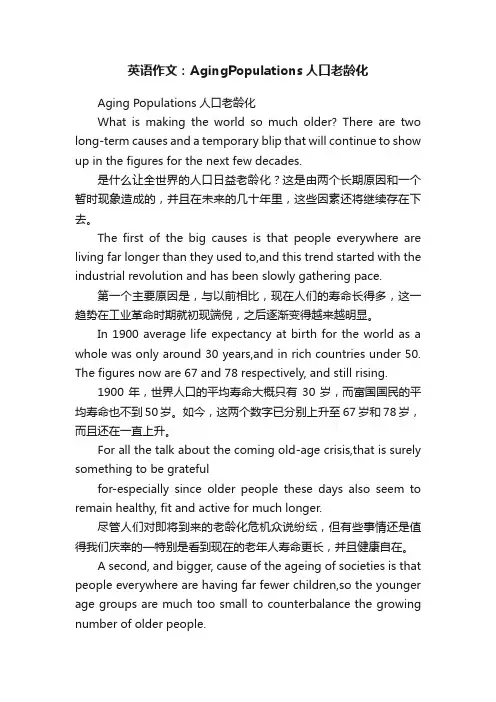
英语作文:AgingPopulations人口老龄化Aging Populations人口老龄化What is making the world so much older? There are two long-term causes and a temporary blip that will continue to show up in the figures for the next few decades.是什么让全世界的人口日益老龄化?这是由两个长期原因和一个暂时现象造成的,并且在未来的几十年里,这些因素还将继续存在下去。
The first of the big causes is that people everywhere are living far longer than they used to,and this trend started with the industrial revolution and has been slowly gathering pace.第一个主要原因是,与以前相比,现在人们的寿命长得多,这一趋势在工业革命时期就初现端倪,之后逐渐变得越来越明显。
In 1900 average life expectancy at birth for the world as a whole was only around 30 years,and in rich countries under 50. The figures now are 67 and 78 respectively, and still rising.1900年,世界人口的平均寿命大概只有30岁,而富国国民的平均寿命也不到50岁。
如今,这两个数字已分别上升至67岁和78岁,而且还在一直上升。
For all the talk about the coming old-age crisis,that is surely something to be gratefulfor-especially since older people these days also seem to remain healthy, fit and active for much longer.尽管人们对即将到来的老龄化危机众说纷纭,但有些事情还是值得我们庆幸的—特别是看到现在的老年人寿命更长,并且健康自在。
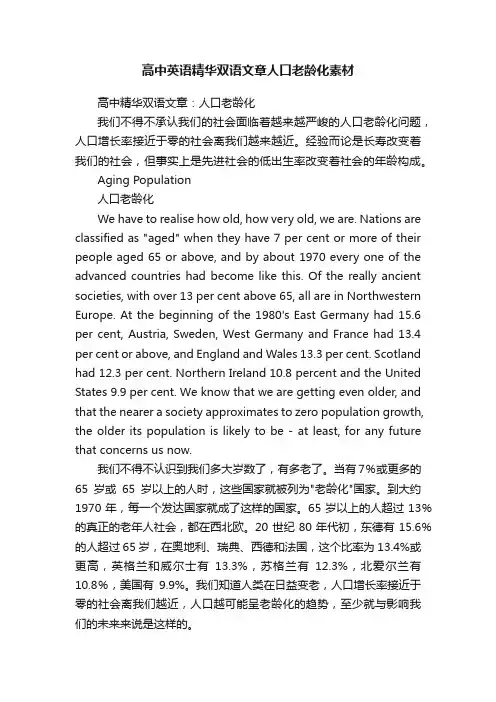
高中英语精华双语文章人口老龄化素材高中精华双语文章:人口老龄化我们不得不承认我们的社会面临着越来越严峻的人口老龄化问题,人口增长率接近于零的社会离我们越来越近。
经验而论是长寿改变着我们的社会,但事实上是先进社会的低出生率改变着社会的年龄构成。
Aging Population人口老龄化We have to realise how old, how very old, we are. Nations are classified as "aged" when they have 7 per cent or more of their people aged 65 or above, and by about 1970 every one of the advanced countries had become like this. Of the really ancient societies, with over 13 per cent above 65, all are in Northwestern Europe. At the beginning of the 1980's East Germany had 15.6 per cent, Austria, Sweden, West Germany and France had 13.4 per cent or above, and England and Wales 13.3 per cent. Scotland had 12.3 per cent. Northern Ireland 10.8 percent and the United States 9.9 per cent. We know that we are getting even older, and that the nearer a society approximates to zero population growth, the older its population is likely to be - at least, for any future that concerns us now.我们不得不认识到我们多大岁数了,有多老了。
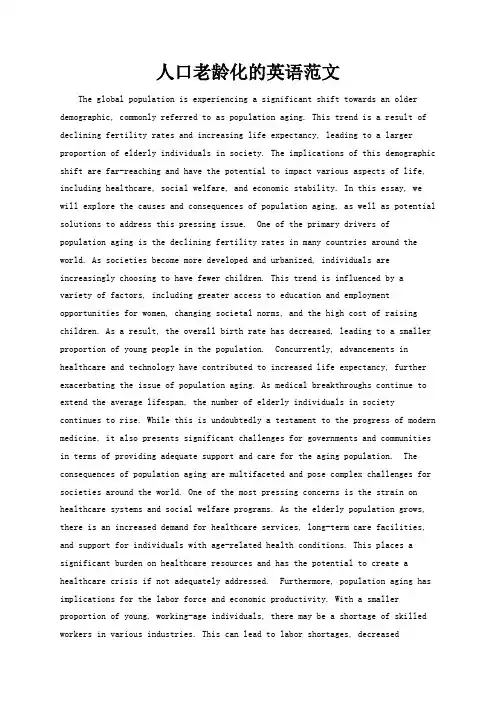
人口老龄化的英语范文The global population is experiencing a significant shift towards an older demographic, commonly referred to as population aging. This trend is a result of declining fertility rates and increasing life expectancy, leading to a larger proportion of elderly individuals in society. The implications of this demographic shift are far-reaching and have the potential to impact various aspects of life, including healthcare, social welfare, and economic stability. In this essay, we will explore the causes and consequences of population aging, as well as potential solutions to address this pressing issue. One of the primary drivers of population aging is the declining fertility rates in many countries around the world. As societies become more developed and urbanized, individuals are increasingly choosing to have fewer children. This trend is influenced by avariety of factors, including greater access to education and employment opportunities for women, changing societal norms, and the high cost of raising children. As a result, the overall birth rate has decreased, leading to a smaller proportion of young people in the population. Concurrently, advancements in healthcare and technology have contributed to increased life expectancy, further exacerbating the issue of population aging. As medical breakthroughs continue to extend the average lifespan, the number of elderly individuals in society continues to rise. While this is undoubtedly a testament to the progress of modern medicine, it also presents significant challenges for governments and communities in terms of providing adequate support and care for the aging population. The consequences of population aging are multifaceted and pose complex challenges for societies around the world. One of the most pressing concerns is the strain on healthcare systems and social welfare programs. As the elderly population grows, there is an increased demand for healthcare services, long-term care facilities, and support for individuals with age-related health conditions. This places a significant burden on healthcare resources and has the potential to create a healthcare crisis if not adequately addressed. Furthermore, population aging has implications for the labor force and economic productivity. With a smaller proportion of young, working-age individuals, there may be a shortage of skilled workers in various industries. This can lead to labor shortages, decreasedproductivity, and potential economic stagnation. Additionally, the growing number of retirees places strain on pension systems and social security programs, asthere are fewer working individuals to support the financial needs of the elderly population. From a social perspective, population aging can also lead toincreased social isolation and loneliness among the elderly. As individuals ageand their social networks shrink, they may experience feelings of loneliness and disconnection from their communities. This has implications for mental health and overall well-being, highlighting the importance of addressing the social aspectsof population aging. In light of these challenges, it is imperative for governments and communities to develop comprehensive strategies to address population aging. One potential solution is to promote policies that support work-life balance and encourage higher fertility rates. This may include initiatives to provide affordable childcare, flexible work arrangements, and financial incentives for families to have more children. By addressing the root causes of decliningbirth rates, societies can work towards achieving a more balanced age distribution in the population. Additionally, there is a need to invest in healthcare infrastructure and long-term care services to support the growing elderly population. This may involve expanding access to geriatric care, increasingfunding for elder care facilities, and implementing programs to support aging in place. By prioritizing the healthcare needs of the elderly, societies can ensure that individuals are able to age with dignity and receive the care and supportthey require. Furthermore, it is essential to foster intergenerational connections and promote social inclusion for the elderly. This can be achieved through community programs that bring together individuals of different age groups, volunteer opportunities for older adults, and initiatives to combat ageism and stereotypes about aging. By creating opportunities for meaningful social engagement, societies can help to mitigate the effects of social isolation and loneliness among the elderly. In conclusion, population aging is a complex and multifaceted issue that has the potential to impact various aspects of society. From healthcare and economic productivity to social well-being, the implicationsof an aging population are far-reaching. By understanding the causes and consequences of population aging, and by implementing comprehensive strategies toaddress this demographic shift, societies can work towards creating a more inclusive and supportive environment for individuals of all ages. It is imperative for governments, communities, and individuals to come together to address the challenges of population aging and ensure a sustainable future for all.。
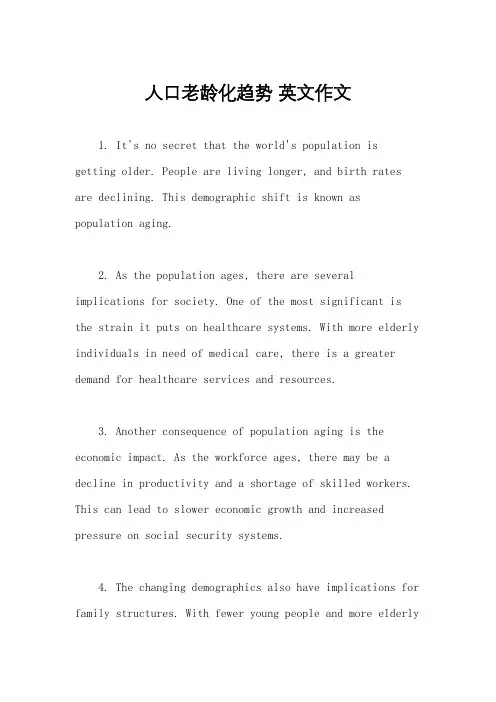
人口老龄化趋势英文作文1. It's no secret that the world's population isgetting older. People are living longer, and birth rates are declining. This demographic shift is known as population aging.2. As the population ages, there are several implications for society. One of the most significant is the strain it puts on healthcare systems. With more elderly individuals in need of medical care, there is a greater demand for healthcare services and resources.3. Another consequence of population aging is the economic impact. As the workforce ages, there may be a decline in productivity and a shortage of skilled workers. This can lead to slower economic growth and increased pressure on social security systems.4. The changing demographics also have implications for family structures. With fewer young people and more elderlyindividuals, the traditional model of the nuclear family may change. There may be a greater reliance on extended family networks or alternative forms of support for the elderly.5. Additionally, population aging can affect the social fabric of communities. Older individuals may face social isolation and loneliness, as they may have fewer social connections and opportunities for engagement. This can have negative implications for mental health and overall well-being.6. Governments and policymakers are aware of the challenges posed by population aging and are taking steps to address them. This includes implementing policies to encourage higher birth rates, promoting healthy aging, and developing strategies to support the elderly population.7. In conclusion, population aging is a global trend that has far-reaching implications for society, healthcare, the economy, family structures, and social well-being. It is important for individuals, communities, and governmentsto adapt and find innovative solutions to address the challenges associated with an aging population.。
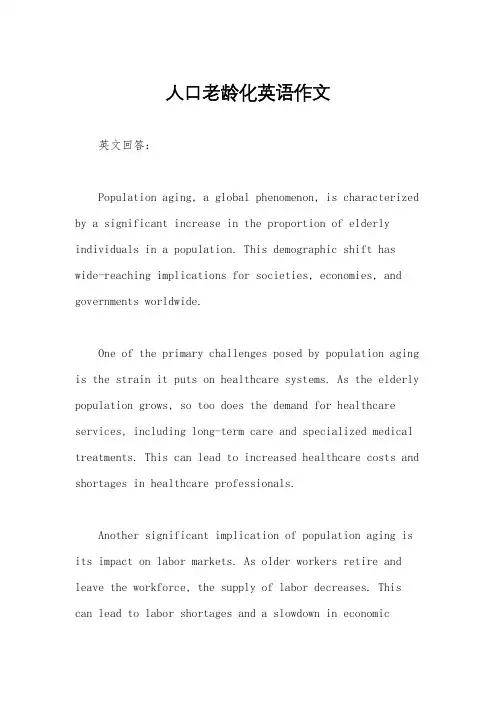
人口老龄化英语作文英文回答:Population aging, a global phenomenon, is characterized by a significant increase in the proportion of elderly individuals in a population. This demographic shift has wide-reaching implications for societies, economies, and governments worldwide.One of the primary challenges posed by population aging is the strain it puts on healthcare systems. As the elderly population grows, so too does the demand for healthcare services, including long-term care and specialized medical treatments. This can lead to increased healthcare costs and shortages in healthcare professionals.Another significant implication of population aging is its impact on labor markets. As older workers retire and leave the workforce, the supply of labor decreases. This can lead to labor shortages and a slowdown in economicgrowth. To mitigate this, governments and businesses may need to implement policies that encourage older workers to remain in the workforce or attract younger workers from other countries.Population aging also has social and cultural consequences. As the proportion of elderly individuals increases, traditional family structures and intergenerational relationships may undergo significant changes. This can lead to challenges related to elder care, housing, and social isolation among older adults.To address the challenges associated with population aging, governments and societies need to implement comprehensive policies and initiatives. These measures may include:Expanding healthcare systems and investing in long-term care services。
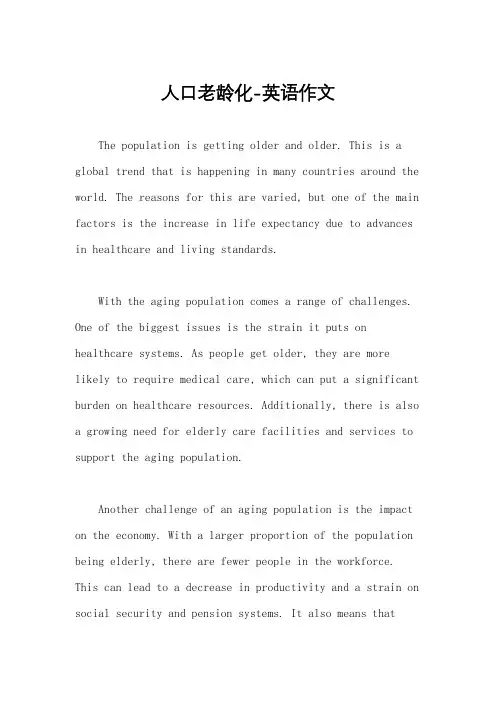
人口老龄化-英语作文The population is getting older and older. This is a global trend that is happening in many countries around the world. The reasons for this are varied, but one of the main factors is the increase in life expectancy due to advances in healthcare and living standards.With the aging population comes a range of challenges. One of the biggest issues is the strain it puts on healthcare systems. As people get older, they are more likely to require medical care, which can put a significant burden on healthcare resources. Additionally, there is also a growing need for elderly care facilities and services to support the aging population.Another challenge of an aging population is the impact on the economy. With a larger proportion of the population being elderly, there are fewer people in the workforce. This can lead to a decrease in productivity and a strain on social security and pension systems. It also means thatthere are fewer people contributing to the economy through spending and taxes.In addition to the economic and healthcare challenges, there are also social implications of an aging population. As the number of elderly people grows, there is a greater need for social support and community services to help them maintain a good quality of life. This can include programs to combat social isolation and provide opportunities for older people to remain active and engaged in their communities.Overall, the aging population is a complex issue that requires careful consideration and planning. It is important for governments and societies to address the challenges that come with an older population and to develop strategies for supporting and caring for the elderly. This may involve rethinking healthcare systems, retirement policies, and social support services to ensure that the needs of the aging population are met.。
人口老龄化趋势英语作文English: The trend of population aging is a global phenomenon that is driven by factors such as declining birth rates, increasing life expectancy, and the Baby Boomer generation reaching retirement age. As societies around the world continue to experience this demographic shift, there are several challenges and opportunities that arise. On the one hand, there is a growing concern about the sustainability of pension and healthcare systems, as fewer working-age individuals are available to support a larger elderly population. This can strain social welfare programs and lead to increased financial burdens on governments. Additionally, there may be an increased demand for long-term care services and facilities as the number of elderly individuals with chronic medical conditions rises. On the other hand, population aging also presents opportunities for economic growth and innovation. For example, the aging population can create new markets for products and services tailored to the needs of older adults, such as healthcare technologies, retirement communities, and leisure activities. There is also the potential for older individuals to continue contributing to the workforce through part-time or consulting roles, tapping into their wealth of knowledgeand experience. Overall, addressing the challenges and opportunities of population aging requires proactive policies and investments in healthcare, social services, and workforce development to ensure the well-being and productivity of aging populations in the future.Translated content: 人口老龄化趋势是一个全球性现象,受到出生率下降、预期寿命增加和婴儿潮一代进入退休年龄等因素的推动。
人口老龄化预测英文作文1. The world is getting older. It's no secret that the global population is aging at an unprecedented rate. The elderly population is growing rapidly, and this trend is expected to continue in the coming decades.2. This demographic shift is mainly due to two factors: declining birth rates and increasing life expectancy. People are having fewer children, and at the same time, advancements in healthcare and living conditions have led to longer lifespans. As a result, the proportion of older people in the population is steadily increasing.3. The implications of this aging population are far-reaching. One of the most significant challenges is the strain it puts on healthcare systems. With more elderly people needing medical care, there is a growing demand for healthcare services, including specialized care for age-related conditions such as dementia and mobility issues.4. Additionally, the economic impact of an aging population cannot be ignored. As the workforce shrinks and the number of retirees grows, there will be a decrease in productivity and a strain on social security systems. Governments will need to find ways to sustain economic growth and ensure the financial stability of their aging populations.5. Moreover, the social dynamics of societies will also change as a result of population aging. Families will have to adapt to the needs of their elderly members, and intergenerational relationships will become increasingly important. Communities and governments will need to create supportive environments that promote active aging andsocial inclusion.6. Despite the challenges, there are also opportunities that come with an aging population. The silver economy, for example, refers to the market potential of goods and services aimed at older people. From healthcare and technology to leisure and tourism, there is a growing market for products and services that cater to the needsand preferences of older consumers.7. In conclusion, the world is experiencing a rapid shift towards an aging population. This demographic change presents numerous challenges, including strains on healthcare systems, economic impacts, and changes in social dynamics. However, it also opens up opportunities for innovation and economic growth. It is crucial for governments, communities, and individuals to adapt to these changes and find ways to ensure the well-being andinclusion of older people in society.。
人口老龄化英语作文人口老龄化英语作文(精选17篇)Population ageing has emerged as a global phenomenon in the wake of the now virtually universal decline in fertility and increases in life expectancy. Many countries are confronted with new demographic realities that spread from the cities to the villages. In my opinion, more problems than benefits will surface with this trend.人口老龄化已成为一种全球性现象,其原因是生育率的普遍下降和预期寿命的增加。
许多国家面临着从城市向乡村蔓延的新人口现实。
在我看来,这一趋势会带来更多的问题,而不是好处。
Population ageing, however, brings about serious economic and social problems. When the number of workers decreases, the national income goes down. At the same time, as a persons use of health services increases significantly in the later years of their life, an ageing population causes a relative rise in the public resources required for pensions, health and residential care outlays.人口老龄化带来了严重的经济和社会问题。
关于人口老龄化的英语作文Title: The Challenge of Population Aging。
Population aging is a global phenomenon that presents both opportunities and challenges for societies worldwide. With advancements in healthcare, sanitation, and living standards, people are living longer lives, leading to an increase in the proportion of elderly individuals within populations. This demographic shift has profound implications for various aspects of society, including healthcare, economy, and social welfare.Firstly, the aging population poses significant challenges to healthcare systems. Elderly individuals typically require more healthcare services due to age-related illnesses and chronic conditions. This increased demand for healthcare puts pressure on existing infrastructure and resources, leading to longer waiting times, higher healthcare costs, and potential strains on healthcare budgets. Moreover, specialized care for age-related conditions such as dementia and mobility issues requires additional resources and expertise, further exacerbating the strain on healthcare systems.Secondly, population aging has economic implications, particularly concerning labor markets and pension systems. As the elderly population grows, the labor force may shrink, potentially leading to labor shortages and decreased productivity. This can have adverse effects on economic growth and competitiveness, as fewer workers are availableto support the economy. Additionally, pension systems may face sustainability challenges as the ratio of retirees to workers increases, putting pressure on governments toreform pension schemes and raise the retirement age.Furthermore, population aging impacts social welfare systems and intergenerational relationships. Elderly individuals often rely on social welfare programs for support, including pensions, healthcare subsidies, andsocial services. As the number of elderly beneficiaries rises, governments may struggle to finance these programs adequately, leading to concerns about social inequality andintergenerational equity. Moreover, the burden of caregiving often falls on family members, particularly women, leading to challenges such as work-family conflicts and financial strain.Despite these challenges, population aging also presents opportunities for innovation and societal adaptation. For instance, advancements in technology and healthcare can improve the quality of life for elderly individuals, enabling them to remain active and independent for longer. Additionally, policies that promote active aging, such as lifelong learning initiatives and community-based programs, can enhance the social inclusion and well-being of elderly populations. Moreover, harnessing the potential of older workers through age-friendly employment practices and lifelong learning opportunities can mitigate labor market challenges and contribute to economic growth.In conclusion, population aging is a complex and multifaceted phenomenon that presents both challenges and opportunities for societies worldwide. Addressing the implications of population aging requires a comprehensiveand integrated approach, encompassing healthcare, economic, and social policies. By investing in healthcare infrastructure, promoting active aging, and adapting social welfare systems, societies can better navigate the demographic transition towards an aging population and ensure the well-being and prosperity of all generations.。
人口老龄化英语作文范文Population aging, characterized by an increasing proportion of older adults relative to the working-age population, poses significant challenges to societies worldwide. This demographic shift is driven by factors such as declining fertility rates and improvements in healthcare leading to longer lifespans. While it reflects progress in health and longevity, it also necessitates strategic planning and policy adjustments to ensure sustainable development.**Economic Implications**One of the most pressing concerns associated with population aging is its economic impact. With a larger elderly population, demands on pension systems and healthcare services intensify, potentially straining public finances. The shrinking workforce may also lead to labor shortages, affecting productivity and economic growth. To mitigate these effects, governments need to consider raising retirement ages, encouraging immigration, and investing in automation and technology to boost productivity.**Healthcare and Social Services**Aging populations require more healthcare and long-term care services. This increased demand necessitates expansion and innovation in healthcare systems, including the development of geriatric care facilities and services tailored to the needs of the elderly. Additionally, there is a need for more healthcare professionals trained in geriatrics to address age-related health issues effectively.**Intergenerational Solidarity**Population aging also impacts intergenerational relationships and family structures. With fewer younger people supporting a growing number of older relatives, there is a risk of intergenerational tension. Promoting intergenerational solidarity through policies that support eldercare responsibilities, such as flexible working hours and tax incentives for caregivers, can help maintain social cohesion.**Technological Solutions**Advancements in technology offer promising solutions to some of the challenges posed by population aging. Telemedicine and remote monitoring devices can improve access to healthcare for the elderly, especially those in rural or remote areas.Smart homes equipped with assistive technologies can enable older adults to live independently for longer, reducing the burden on caregivers and healthcare systems.**Education and Lifelong Learning**To remain active and engaged in society, older adults should have access to educational opportunities and programs that promote lifelong learning. This not only enhances their quality of life but also contributes to the economy by keeping their skills relevant and fostering intergenerational knowledge transfer.In conclusion, addressing the challenges of population aging requires a multifaceted approach involving economic reforms, healthcare system enhancements, technological innovations, and social policy adjustments. By taking proactive measures, societies can harness the potential of their aging populations and ensure that they age gracefully, healthily, and with dignity.。
人口老龄化英语作文The Aging Population。
With the advancement of medical technology and improvement of living standards, the global population is experiencing an unprecedented aging trend. This phenomenon, known as population aging, is characterized by an increasein the proportion of elderly people in the total population. This trend has profound implications for individuals, societies, and governments.There are several reasons behind the aging population. Firstly, the declining fertility rate is a major factor. As people's living conditions improve, they tend to have fewer children. In addition, the average life expectancy has increased significantly due to better healthcare and living conditions. Moreover, the baby boomer generation, bornafter World War II, is now entering old age, further contributing to the aging population.The aging population poses numerous challenges. One of the most significant challenges is the strain on healthcare systems. As people age, they are more prone to chronic diseases and require more medical attention. This puts a burden on healthcare resources and increases healthcare costs. Furthermore, the aging population also leads to a shrinking workforce. With fewer young people entering the labor market, there may be a shortage of skilled workers, which could hinder economic growth.The social and psychological impacts of an aging population cannot be ignored either. Elderly people often face social isolation and loneliness, as their friends and family members pass away or move away. This can lead to mental health issues such as depression and anxiety. Moreover, the traditional family structure is also changing. In the past, elderly parents were often taken care of by their children. However, with smaller family sizes and increasing urbanization, this is becoming less common. As a result, there is a growing need for social welfare programs and support services for the elderly.To address the challenges posed by an aging population, governments and societies need to take proactive measures. Firstly, healthcare systems should be strengthened to provide better medical care for the elderly. This includes increasing the number of healthcare professionals, improving elderly care facilities, and implementing preventive healthcare measures. Secondly, there should be a focus on promoting healthy aging and active lifestyles. This can be done through public awareness campaigns, providing recreational activities for the elderly, and creating age-friendly communities. Additionally, governments should implement policies to encouragefertility and support working parents, in order to mitigate the effects of declining birth rates.In conclusion, the aging population is a global phenomenon that has far-reaching implications. It iscrucial for governments, societies, and individuals to recognize and address the challenges posed by population aging. By implementing appropriate measures, we can ensure that the elderly population receives the care and supportthey need, and create a society that values and respects people of all ages.。
文献信息(仅翻译文献综述部分)文献标题:The Relation between the Migration, Population Aging, Labor Force Productivity and Economic Growth: An Analysis for Bulgaria(移民、人口老龄化、劳动力生产率与经济增长的关系:以保加利亚为例)文献作者:Venelin Terziev, Hamit Can文献出处:《Social Science Electronic Publishing》 , 2018字数统计:英文2655单词,14234字符;中文4285汉字外文文献The Relation between the Migration, Population Aging,Labor Force Productivity and Economic Growth:An Analysis for BulgariaThe recent aging of the population is one of the most important issues that many developed and developing countries are interested in (Bloom et al., 2011: 1). Population aging and demographic transformation at the global and national level, economic, social, demographic and so on. Causing various problems to occur.The most important of the problems caused by the aging of the population is the change of labor supply. As the population changes in age composition, the population that cannot participate in economic activities and has no participation in the labor force is increasing and the labor supply is changing. As the number of people aged 60 years and over in the age structure of the population increases, the number of working age population is decreasing. The change in the age structure of the population affects the growth of the labor market and employment and the economic growth of the population, the aging of the population, the total labor force supply, the productivity of the old labor force, employment structure, wage income, savings, production and consumption. The age structure of the population is a very important external variablethat affects economic growth. In addition to the effects of increased elderly population, labor market and economic growth, the impacts on health and social security systems are also very important (Bloom et al., 2008: 15-16; Bloom et al).The study of the effects of age change on economic growth in studies on the relationship between population aging and economic growth, exploits the lifetime income hypothesis. According to Modigliani and Brumberg's 1954 and 1980 studies of Ando and Modigliani's 1963 study of Lifetime Income Hypothesis, individuals' working and participating economic needs and saving vary according to their life span. While participation at young ages, consumption trends and savings are high, participation in the production of elderly products, and especially savings, falls considerably. People have a higher saving during their lifetime especially when their incomes are higher and when they participate in production. The reason for this is that they can continue their consumption in old age during their retirement periods when their income falls. This means that the total labor supply, productivity, income and per capita savings vary according to these trends as a result of the majority of individuals acting according to the lifetime income hypothesis. Total labor supply, productivity, income and per capita savings are important factors in determining economic growth. Especially the age group is big on labor supply and per capita savings. The labor supply and per capita savings of those aged 60 and over are lower than the labor supply and per capita savings of working adults. In this context, although there is no change in the productivity and income factors that are important in determining economic growth, slower growth is likely to occur due to the surplus of the elderly age group. This approach has been assessed in Bloom and Williamson's study of the effects of population aging on the rapid economic growth of East Asia in 1998, the second half of the 20th century. In the late 1940s, infant and child mortality decreased in these countries and therefore there was a decrease in fertility. As a result of death rates and reductions in fertility, a new generation of newborns has begun to emerge. When this generation reaches its working age, it has made significant increases in labor supply and saving. According to Bloom and Williamson (1998) and Bloom, Canning, and Malaney (2000), the miracle of growth in East Asia during 1965-1990 isexplained by the actual demographic change (Bloom et al., 2008: pp. 1-38; Bloom et al. 2011: pp. 12-13; Deaton, 2000: pp. 1-46).The decline in the age-old population that can work after the aging of the population causes the workforce in the economy to become a scarce factor of production. In countries with older populations, the number of working people entering the labor market is reduced, while the lower productivity due to the physical and mental wear of the older workforce reduces the total labor supply. Another consequence of population aging is that the increase in social security and tax cuts also has a different impact on the labor market. The increase in the elderly and dependent population increases the cost of financing pension benefits. This increasing burden is affecting the population working through the social security system. This means that the cost of labor increases. The increase in labor costs, which constitutes a major obstacle to employment, also reduces the tendency to work for the employer while reducing the tendency to work for the working population on the one hand. Compulsory interruptions of the social security system have an increasing effect on unemployment (Salin, 1996: pp. 25-26). Young people who have recently completed their education constitute a general human capital that can integrate technological innovations (Железаров, 2009; Железаров, 2005; Иванов, Железаров, 1998). However, despite the fact that the human capital of an employee who has worked for the same company over a long period has its own advantages, the transfer of this human capital from one place to another has been difficult and useless. At the same time, it is believed that the elderly are at the lowest productivity level in general for all employers (Santos, 2001). In addition, companies prefer young people to depreciate costs such as recruitment and training, assuming they will work longer than elderly people (Jolivet, 2001: pp. 65-82).With the aging of the population, a number of possible developments are expected, especially in the developed countries, in relation to the banking sector. There is an expectation on the active sides of the banks that the demand for the loan will decrease with the decrease of the young population. Therefore, the volume of individual credits is expected to decrease. On the passive side of the banks, it maycome into question that the tax incentives and subsidies required by the public for the creation of new saving instruments together with the aging population may come into question. Pension fund schemes have also been consolidated within the framework of more serious risk surveillance, particularly in the Netherlands, and in some other European countries. In addition, there is a need for efforts to make up for falling claims by other products for the elderly and retired population. It is anticipated that the evaluation of non-bank financial institutions such as insurance companies, pension funds and mutual funds will also increase the demand for such institutions (Groome et al., 2006, pp. 44-47). Due to these developments, it is expected that there will be a downward pressure on the demand for bank loans and deposits. In this way, banks will need to pursue more competitive policies in order for their growth to continue.Prettner (2012) and Lee et al. (2011), but most of the literature in the literature suggests a negative relationship between population aging and economic growth (Narciso, 2010; Bloom et al., 2010, pp. 583-612; Lisenkova et al., 2012, pp. 12-13; Walder and Döring, 2012, pp. 63-80). Hock and Weil (2012); Walder and Döring (2012) argue that the increase in aging populations will cause a decline in consumption and growth will be hindered.Auerbach et al. (1989) OECD members have identified the economic dynamics of population aging across the four countries. The result of the study is that national savings rates, real wage rates and demand deposits are highly sensitive to the old dependency rate. Barlow (1994) examined the relationship between population growth and economic growth. In the short term, the increase in fertility has a negative effect on the growth of per capita income; Whereas in the long run the direction of this effect changes positively. Because today's fertility rate is highly correlated with past fertility and population growth rate will be negative in the short term and positive in the long term. Bloom et al. (2011) The results of population aging have been analyzed for economic growth. For OECD countries, the prolongation of life expectancy, the downsizing of families, more savings for retirement, and increased participation rates in the female workforce will not be adversely affected by the aging of the economic growth population. However, in countries that are not members of theOECD, especially in developed countries, the labor force that can be employed due to the aging of the population is experienced and therefore the production will be adversely affected. Bloom et al. (2001) The relationship between economic growth and demographic transformation is examined in East Asia, Japan, OECD, North America, Eastern Europe, North Asia, Latin America, the Middle East and South Africa and Saharan countries. Changes in the age structure of the country have significant effects on the economic performance of the country. Countries with high rates of children allocating resources to child care from their national income cause pressure on the rate of economic growth. Conversely, if the density of working population of an country is too high, any additional production of this group will positively affect economic growth. Middle age and older age groups will have a large share, and a significant portion of the country's resources will be made available to the needs of those not in production. Bloom et al. (2006) examined the impact of demographic change on the social security system and savings. The results of macroeconomic panel data analysis show that post-retirement social security incentives increase the total savings in countries. However, in countries where social security is provided by intergenerational solidarity, this positive effect disappears. Bloom et al. (2009) examined the relationship between population aging and economic growth. Participation in the workforce will be reduced at this point, as a decrease in the fertility rate will lead to a decrease in the rate of young dependency but an increase in the rate of older dependency. In addition, the decrease in fertility will increase women's participation in the workforce, leading to a perceived increase in the proportion of the workforce to population. Boersch-Supon (2001) The effects of population aging on the saving behavior of individuals and their impact on the capital market have been examined. The aging of the population has led to the fact that the intergenerationalism in the social security system is more prevalent and that economies such as Germany, France and Italy, which have poor capital markets and poor capital performance, are more influential on capital markets. The younger generations in these countries are aware of the need to meet their retirement income needs with their own private savings. As a result, the aging of the population seriouslychanges the macroeconomic balance of Europe. Cutler (1990) examined the opportunities and changes that population aging can bring. Although demographic changes will create an increase in per capita income in the near future, unlike changes in capital intensity; While in the distant future there will be a decrease in per capita income. Deaton and Paxson (2000) investigated how demographic changes in the population will affect future saving trends, particularly in the Taiwan country. It has been found that the change in demographic structure of the population is an individual result, not a generality of the nation, but an increase in saving. Accordingly, young people in Taiwan are accumulating more for the future than what their parents did when they were at their age. For this reason, there is no direct relationship between age and saving rate. Fogel (1994) identified economic growth and assessed the impacts on population rates. Population forecasting, national income measurement, leisure time requirements, pension policies and the demand for health services are the result of economic growth theory. Harris et al. (2001) The impact of population aging on public education expenditures has been examined. According to the estimated results of the model, the aging of the population has a negative effect on the education expenditures. The increase in the share of aging in the nation puts pressure on education expenditures. Higgins (1998) examined the relationships between age distributions, national savings and current account balance. According to panel data analysis results using time series data for 100 countries, the increase in the dependency ratio of young people and the elderly is associated with low saving rates. For this reason, demographic changes are effective in determining the current account balance. Kelley and Schmidt (1996) investigated the impact of population growth on economic growth. According to comparative country analyzes, the direction of the effect of population aging on economic growth is negative in the 1980s; The influence in the 1960s and 1970s is meaningless. Lee and Mason (2010) examined the relationship between fertility, human capital and economic growth in the demographic transformation process. Increasing human capital investments with decreasing fertility rates initially reduce consumption with a decline in fertility rate, but aging of the population and transfer payments made by the elderly increase consumption. Lefebvre(2006) analyzed the effect of population aging on consumer demand in Belgium. Because consumption expenditures vary throughout life, the structure of total consumption varies with the age of the population. Increased health, shelter and leisure spending with aging; Clothing, equipment and transport expenditures. Leibfritz et al. (1995) Analyzed the impact of demographic changes on public and national savings. Changes in the demographic structure can only be achieved by improvements in the financial structure of the countries. For this reason, the increase in retirement age is still a matter of debate as it will make a major contribution to the social insurance system. Zweifel et al. (2004) examined the effect of population aging on health expenditures. By examining the health expenditures of the deceased people, it is concluded that the age of health expenditures is insignificant. For this reason, the aging of the population will not have a significant impact on future health expenditures. Fougere and Merette (1991) investigated the effects of population aging on economic growth in seven industrialized countries of the United Kingdom, France, Italy, Sweden, Japan, Canada and the United States. The OLG model of Hviding and Merette (1998) was used in the general equilibrium model together with the theory of internal growth. Population aging causes significant changes in economic growth in the long run. Aging can provide many opportunities for future generations. Investments in human capital, especially made for future generations, significantly reduce the negative effect of aging on per capita output. Prettner (2009) The effect of population aging on economic growth in the long run has been examined. Romer (1990) and Jones (1995) model was used as the internal growth model. The increase in lifetime has a positive effect on the increase in per capita output in the long run. Futugami and Nakajima (2001) The effect of population aging on economic growth has been examined. With the theory of internal growth, the lifetime savings model in the general equilibrium theory is used. Population aging is not a factor that negatively affects economic growth. In addition, the effects of postponing retirement policies have been examined and these policies have been achieved as a result of slowing growth. Bloom et al. (2003) investigated the lifetime savings and working life of the length of life along with changes in the age structure of the population. The timeseries has been used and the increase over the lifetime increases the saving rates. But even in the case of a constant population growth, the prolongation of the life span compensates for the saving rates due to the increase in the old age dependency ratio. Life span increases average saving rates.However, when the age structure reaches equilibrium, these increases are beginning to decrease. The European Commission's research on aging in 2012 on the impact of public spending has indicated that a significant reduction in the labor supply is expected when the demographic transition comes to 2050. 30% in Italy and 17% in Germany (Economic Policy Committee and European Commission, 2006). These results indicate that migration figures may or may not increase for closure of employment openness.中文译文移民、人口老龄化、劳动力生产率与经济增长的关系:以保加利亚为例最近的人口老龄化是许多发达国家和发展中国家感兴趣的最重要问题之一(Bloom等,2011年:第1页)。